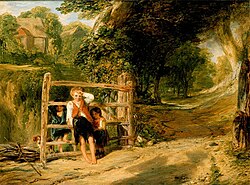William Collins (painter)
William Collins RA | |
|---|---|
 Portrait of William Collins (1831) by John Linnell | |
| Born | 8 September 1788 London, England |
| Died | 17 February 1847 (aged 58) London, United Kingdom |
| Nationality | English |
William Collins
Life and work



Collins was born in
In 1811, Collins sold a picture entitled The Young Fifer to the Marquis of Stafford for 80
In 1815, Collins undertook a sketching tour of the coast near
In 1820, Collins was elected a Royal Academician (RA), presenting as his diploma picture The Young Anglers. In 1822 he married Harriet Geddes, sister of the portrait painter

In September 1836, Collins left London for Italy, where he remained for two years, occupying himself with advancing his knowledge of painting, but he had to return due to illness. He then began a series of pictures depicting Italian life, including Poor Travellers at the door of a Capuchin Convent near Vico, Bay of Naples[6] and A Scene near Subiaco, both exhibited at the Royal Academy in 1839. They were followed in 1840–1841 by two New Testament subjects: Our Saviour with the Doctors in the Temple, and The Two Disciples at Emmaus.[1]
From 1840 to 1842 Collins was librarian to the Royal Academy and in 1843 moved to a large house at 1 Devonport Street, Hyde Park Gardens. In 1840 he visited
In 1846 Collins's Early Morning was exhibited.
Death

Collins died of heart disease, "terminating in dropsy", in Devonport Street on 17 February 1847. He was buried in the cemetery of the church of St. Mary, Paddington, where a monument in the form of a cross was erected by his widow.[1] The grave now stands isolated, on the north side of St Marys Gardens, after the churchyard's conversion into a public park in 1881. It has been vandalised, and the marble cross is missing; the inscription is also eroding.
He left two sons, the elder being the novelist William
Works
Collins exhibited at the Royal Academy every year from 1807 to 1846 (a total of 124 pictures) and showed 45 pictures at the British Institution. His major works are listed in Volume 2 (pp. 341–352) of "Memoirs" (see Bibliography).
Today his works appear in the collections at the Victoria and Albert Museum and Tate Britain in London and at other regional centres.
Notes
- ^ a b c d e f g h i j k l Stephen, Leslie, ed. (1887). . Dictionary of National Biography. Vol. 11. London: Smith, Elder & Co. pp. 380–81.
- ^ Gerald Reitlinger, The Economics of Taste, London 1959, I.82, 277, 470)
- ^ His father, a native of Wicklow, Ireland, wrote a biography of George Morland, a poem on the slave trade, and other work.
- ^ Collins biog (www.wilkie-collins.info)
- ^ "Scene on the Coast of Norfolk". Royal Collection.
- ^ See "Poor Travellers". Liverpool Museums.
- ^ "William Collins RA". Retrieved 22 February 2021.
Bibliography
 This article incorporates text from a publication now in the public domain: Fagan, Louis Alexander (1885–1900). "Collins, William (1788-1847)". Dictionary of National Biography. London: Smith, Elder & Co.
This article incorporates text from a publication now in the public domain: Fagan, Louis Alexander (1885–1900). "Collins, William (1788-1847)". Dictionary of National Biography. London: Smith, Elder & Co.- Wilkie Collins, Memoirs of the life of William Collins, Esq., R. A: Volume 1, Volume 2 (London: Longman, Brown, Green and Longmans, 1848)
External links
- 81 artworks by or after William Collins at the Art UK site
- W. Collins online (ArtCyclopedia)
- W. Collins biography and works
- Returning from the Haunts of the Seafowl (Walker Art Gallery)
- W. Collins archive (Royal Academy Collection)
- Scene from the Caves of Ulysses, at Sorrento (1841, oil on canvas)
- Hall Sands, Devo (1846, oil on canvas - V & A)
- A country kitchen (1811, oil on canvas - V & A)
